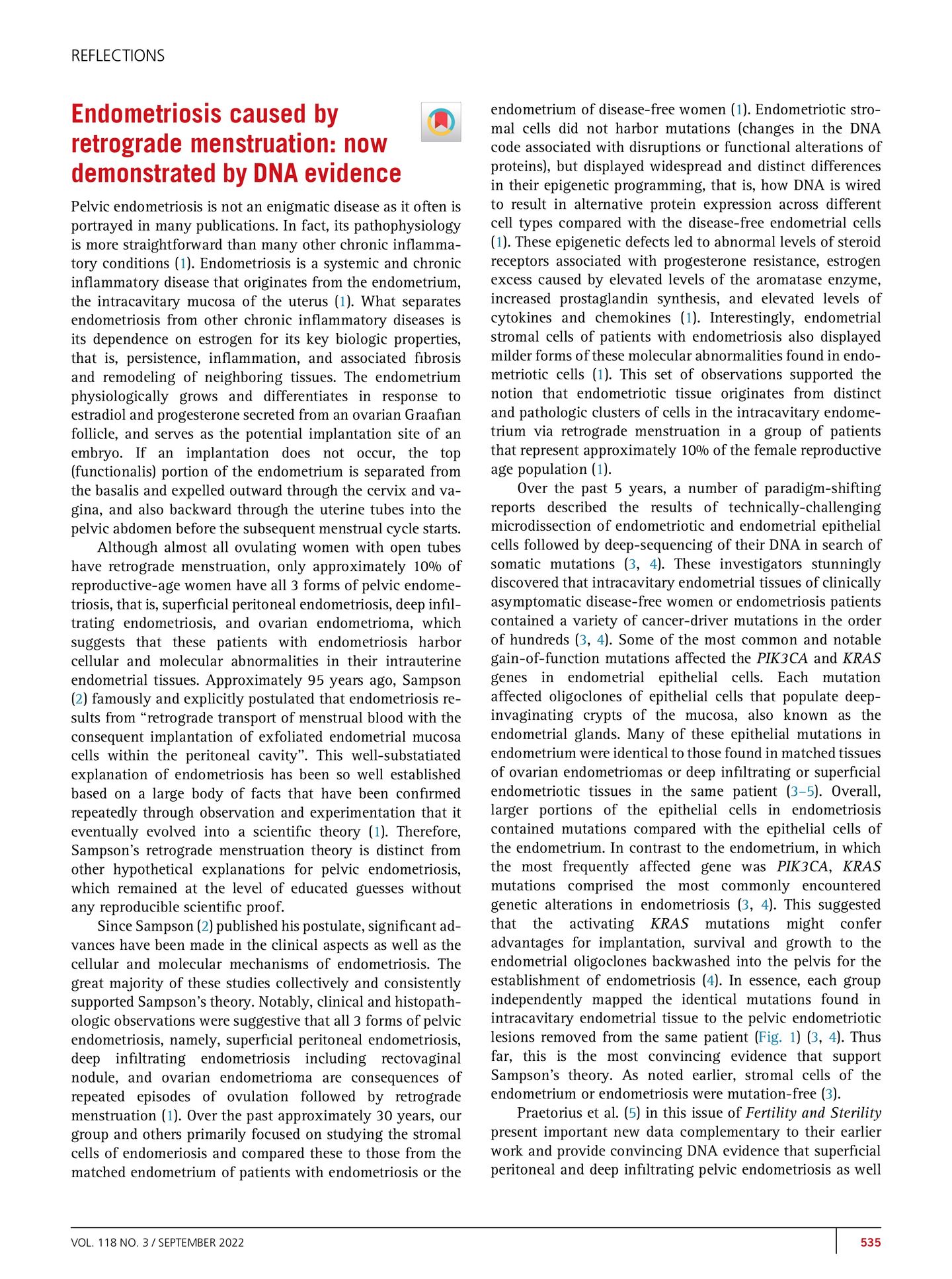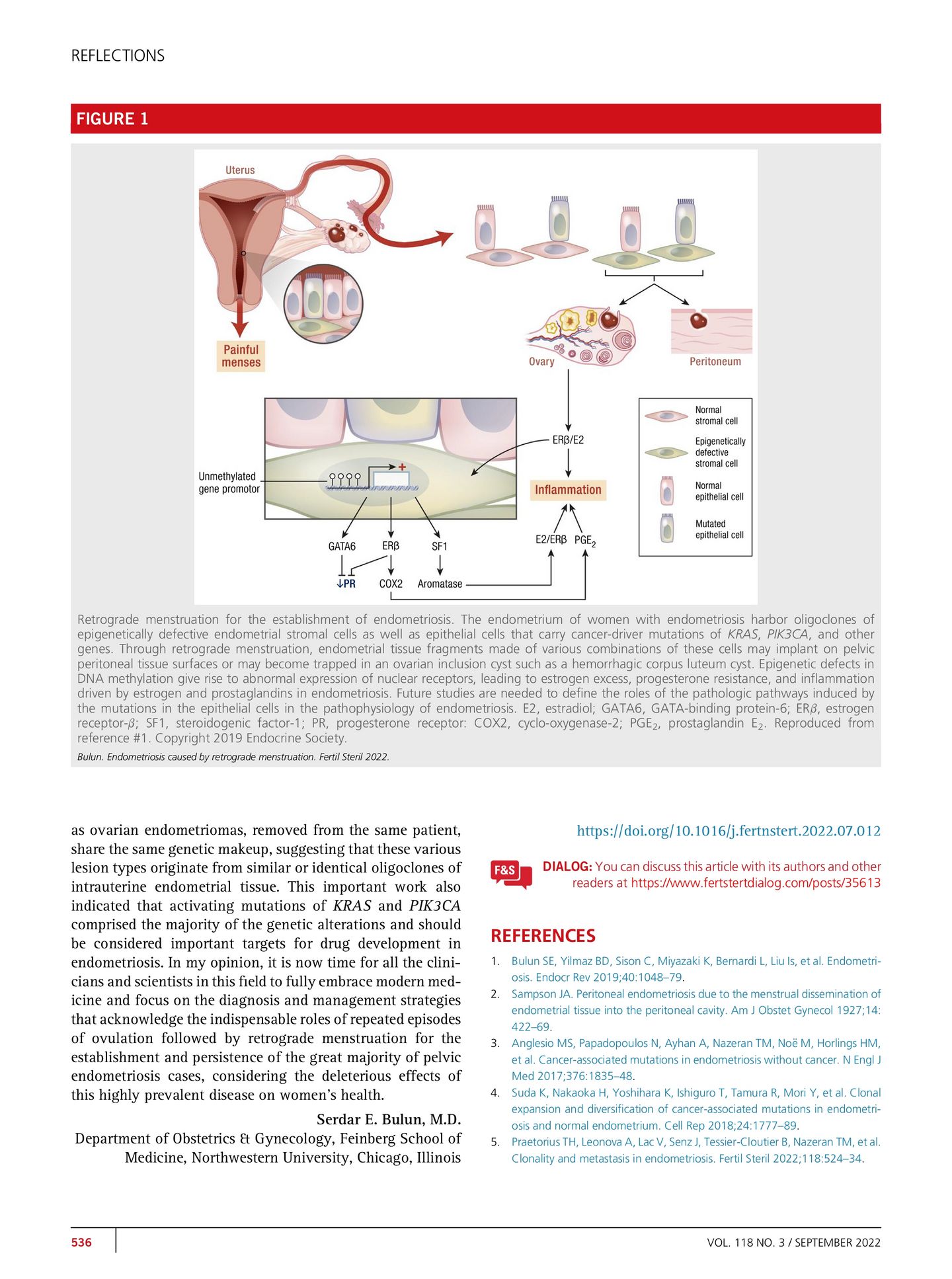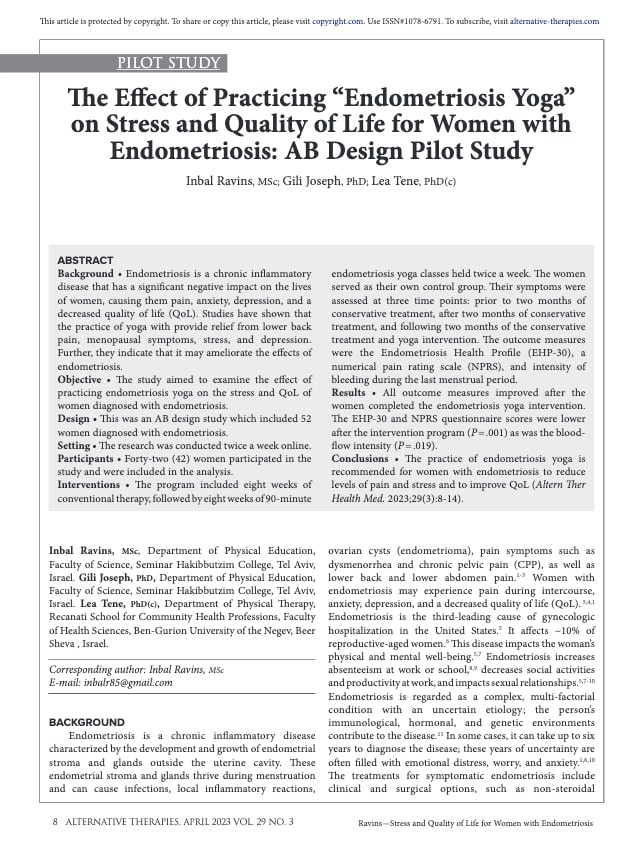
Endometriosis – Does It Concern Me?
Endometriosis occurs when tissue, which typically lines the uterus, is found outside of it. This condition is more common than often assumed – about 10% of young women might be affected.
Symptoms include abdominal pain, excessively heavy menstruation, pain during sex, and bowel movements, as well as potential infertility. Approximately half of all menstrual-related complaints are linked to endometriosis. In some women, however, tissue situated outside the uterus causes no or only mild symptoms, leaving many cases undetected.
The exact causes of endometriosis are not fully understood, but it is believed to result from a combination of genetic, immunological, and hormonal factors. One theory is the so-called retrograde menstruation, where menstrual blood and tissue travel backward through the fallopian tubes into the abdominal cavity, leading to the formation of endometriosis lesions [Bulun 2022, Halme 1984, Seli 2003b].
Although retrograde menstruation can be observed in 76-90% of menstruating women, only a smaller portion develops endometriosis, suggesting that additional factors such as hormonal, inflammatory, or immunological environments could play a role [Seli 2003a].
Diagnosis is often made through a gynecological examination, ultrasound, or even laparoscopy. Treatment? As unique as the woman herself, ranging from painkillers to hormonal therapies to surgical interventions, always considering well-being and family planning.
Debunking Yoga Myths: Do Inversions Risk Endometriosis?
In yoga circles, there's often talk about avoiding inversions during menstruation. Some yoga teachers advise against these poses during this time, fearing that they could disrupt the natural flow and potentially worsen endometriosis. This caution is often associated with the teachings of BNS Iyengar, though direct quotes are scarce. Still, the recommendation persists among yoga enthusiasts.
However, my research didn't find clear scientific evidence supporting this connection. Both in yoga and other sports, the impact of inversions on retrograde menstruation hasn't been definitively proven. It's essential to note that even if inversions increase retrograde menstruation, it doesn't necessarily lead to endometriosis. After all, 70 to 90% of women experience retrograde menstruation.
Nonetheless, there are plenty of beautiful yoga poses that don't involve inversions. So, while it might just be a myth, I suggest enjoying your yoga practice without prolonged inversions during menstruation.
Yoga Nidra - For Hormonal Harmony
A study shed light on the impact of Yoga Nidra on women experiencing menstrual issues. Remarkably, regular practice of this guided relaxation significantly improved hormonal balance. Yoga Nidra was shown to substantially reduce levels of thyroid-stimulating hormone, follicle-stimulating hormone, luteinizing hormone, and prolactin compared to a control group.
Especially for common issues like heavy menstruation or pain, Yoga Nidra promises relief and enhances well-being. It's a natural boon for any woman seeking to bring her body back into balance [Rani 2013].
Endometriosis Yoga - For Enhanced Well-Being
A study titled 'The Effect of Practicing 'Endometriosis Yoga' on Stress and Quality of Life for Women with Endometriosis' explored how yoga tailored for endometriosis could influence stress and life quality for affected women.
The pilot study involved 52 women diagnosed with endometriosis who first underwent eight weeks of conventional therapy, followed by eight weeks of specialized Endometriosis Yoga for 90 minutes twice a week. The findings indicated improvements in pain levels, stress, and overall quality of life following the yoga intervention [Ravins 2023].
Gentle Hatha Yoga – A Blessing for Endometriosis Relief
Another study titled "The Practice of Hatha Yoga for the Treatment of Pain Associated with Endometriosis" investigated the effects of yoga on chronic pelvic pain, menstrual patterns, and quality of life in women with endometriosis through a randomized controlled trial. Participants were divided into two groups: one group (28 participants) participated in an 8-week yoga program, while the other group (12 participants) did not receive any yoga intervention. It was found that the yoga group experienced a significant reduction in daily pain and improvements in various aspects of quality of life [Gonçalves 2017].
Similar findings were reported by the same researchers in a precursor study [Gonçalves 2016]. Participants reported being able to experience better mind-body integration during yoga practice, particularly finding breathing exercises and enhanced self-awareness helpful.
Gentle Strength: Pelvic Floor Training and Endometriosis
Physiotherapy and exercise therapy, especially for the pelvic floor, is considered the first and most important measure for endometriosis symptoms. This therapy focuses on pelvic floor dysfunctions and musculoskeletal imbalances that often accompany endometriosis. Targeted training, as well as relaxation exercises, help to break the vicious cycle of inflammation, irritation, and pain.
It is important to practice in a way that is individually tailored. In some women, the pelvic floor may be hardened and chronically cramped, while in others it may be weakened and slack. The vision of the training is a pelvic floor that can harmoniously build, release, and maintain tension. The more experience a therapeutic yoga instructor has in this area, the more individually they can tailor the exercises.
For example, for women who suffer from a tense pelvic floor, classic Kegel exercises, which are based on tension, might not be the optimal choice. In such cases, 'Reverse Kegels', which emphasize relaxing the pelvic floor, may be more beneficial. Additionally, stretching exercises can be an important part of the treatment. It is also crucial to integrate the pelvic floor dynamically into movements of the entire body, rather than limiting it to purely static activation.
Unfortunately, research, at least according to my literature research, is currently more focused on surgical treatment outcomes. In my opinion, there is definitely room for studies on the benefits of different types of pelvic floor training.
Recommendations from the Yoga Doc – Syncing with the Cycle
Based on this, I recommend integrating specially tailored yoga poses into a program designed for endometriosis symptoms, focusing particularly on relaxing postures, such as those found in Yin Yoga. These poses offer the easiest access to gentle self-awareness. Relaxation appears to promote hormonal balance. Combined with calming breathing exercises, this creates a well-suited yoga practice.
In this practice, it's best to avoid inversions. Instead, there's room for strengthening exercises, especially targeted relaxation techniques for the pelvic floor and deep abdominal muscles.
Literature
Bulun SE. Endometriosis caused by retrograde menstruation: now demonstrated by DNA evidence. Fertil Steril. 2022 Sep;118(3):535-536. doi: 10.1016/j.fertnstert.2022.07.012. PMID: 36116802. pubmed.ncbi.nlm.nih.gov/36116802/
Gonçalves AV, Makuch MY, Setubal MS, Barros NF, Bahamondes L. A Qualitative Study on the Practice of Yoga for Women with Pain-Associated Endometriosis. J Altern Complement Med. 2016 Dec;22(12):977-982. doi: 10.1089/acm.2016.0021. Epub 2016 Aug 23. PMID: 27552065. pubmed.ncbi.nlm.nih.gov/27552065/
Gonçalves AV, Barros NF, Bahamondes L. The Practice of Hatha Yoga for the Treatment of Pain Associated with Endometriosis. J Altern Complement Med. 2017 Jan;23(1):45-52. doi: 10.1089/acm.2015.0343. Epub 2016 Nov 21. PMID: 27869485. pubmed.ncbi.nlm.nih.gov/27869485/
Halme J, Hammond MG, Hulka JF, Raj SG, Talbert LM. Retrograde menstruation in healthy women and in patients with endometriosis. Obstet Gynecol. 1984 Aug;64(2):151-4. PMID: 6234483. pubmed.ncbi.nlm.nih.gov/6234483/
Rani M, Singh U, Agrawal GG, Natu SM, Kala S, Ghildiyal A, Srivastava N. Impact of Yoga Nidra on menstrual abnormalities in females of reproductive age. J Altern Complement Med. 2013 Dec;19(12):925-9. doi: 10.1089/acm.2010.0676. Epub 2013 May 6. PMID: 23647406. pubmed.ncbi.nlm.nih.gov/23647406/
Ravins I, Joseph G, Tene L. The Effect of Practicing "Endometriosis Yoga" on Stress and Quality of Life for Women with Endometriosis: AB Design Pilot Study. Altern Ther Health Med. 2023 Apr;29(3):8-14. PMID: 35839113. pubmed.ncbi.nlm.nih.gov/35839113/
Seli E, Arici A. Endometriosis: interaction of immune and endocrine systems. Semin Reprod Med. 2003 May;21(2):135-44. doi: 10.1055/s-2003-41320. PMID: 12917783. pubmed.ncbi.nlm.nih.gov/12917783/
Seli E, Berkkanoglu M, Arici A. Pathogenesis of endometriosis. Obstet Gynecol Clin North Am. 2003 Mar;30(1):41-61. doi: 10.1016/s0889-8545(02)00052-9. PMID: 12699257. pubmed.ncbi.nlm.nih.gov/12699257/
-
Passt das Beckenbodentraining für Endometriose, das du hier zeigst? https://www.youtube.com/watch?v=vOLjWXQEi98 Passt das Beckenbodentraining für Endometriose, das du hier zeigst? https://www.youtube.com/watch?v=vOLjWXQEi98
-
Hallo Kerstin,
ja das ist eine Stunde in der viel passendes drin ist.
1) Beckenbodentraining ist dynamisch in komplexe Ganzkörperbewegungen eingebaut.
2) Entspannung am Ende definitiv wichtig. Vor [...] Hallo Kerstin,
ja das ist eine Stunde in der viel passendes drin ist.
1) Beckenbodentraining ist dynamisch in komplexe Ganzkörperbewegungen eingebaut.
2) Entspannung am Ende definitiv wichtig. Vor allem auch in dieser Form oft sehr angenehm.
... der Rest dazwischen formen die ganzheitliche Praxis: Wie immer - nach den eigenen bedürfnissen anzupassen.
Namaste und beste Grüße
Ronald
-



 Dr. Ronald Steiner
Dr. Ronald Steiner






Messages and ratings